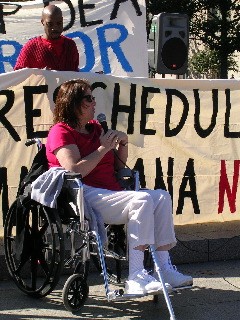Last spring, the Rhode Island legislature approved a bill to allow for the creation of dispensaries for medical marijuana patients. Last week, in response to that legislation, the state Department of Health issued its proposed dispensary rules. A public hearing on the draft is set for February.

State health officials told the Providence Journal that if, after the public hearing, no revisions in the draft were necessary, the new rules could be enacted within 45 days. Then, the licensing process allows for up to 60 days to approve the applications. That brings the timeline to mid-2010, and that's if there are no additional public hearings and no major revisions demanded.
Even after dispensary operators are approved, it will take time to find financing and suitable locations. Once the facility is set up, it will take at least an additional three months before the first medicinal crop can be harvested. It could well be a year before Rhode Island sees a dispensary.
Under the proposed rules, a dispensary is defined as nonprofit entity that "acquires, possesses, cultivates, manufactures, delivers, transfers, transports, supplies, or dispenses marijuana... to registered qualifying patients and their registered primary caregivers."
Patients are limited to 12 plants and 2.5 ounces of usable marijuana. Dispensaries would be able to provide for multiple patients and would be allowed to keep on hand only 12 plants and 2.5 ounces per patient. The dispensaries could not provide a patient with more than 2.5 ounces in any 15-day period.
The proposed regulations do not address what prices dispensaries could charge. Instead, they say only that as licensed caregivers, they would be allowed to be reimbursed for the costs associated with helping a patient.
People complying with the Rhode Island medical marijuana law would be protected from arrest or prosecution, and they could not be penalized by schools, employers, and landlords. Dispensaries could not operate within 500 feet of a school and must have an alarm system.
The proposed rules bar people with drug felonies -- but not other felonies! -- from operating or working for a dispensary, unless their offenses would not be offenses under the Rhode Island medical marijuana law. It also allows the Department of Health to waive that requirement if it wishes.
This work by StoptheDrugWar.org is licensed under Creative Commons Attribution-ShareAlike 4.0 International
Comments
cost
i wonder if the med-marijuana is going to be below street prices... the first crop to produce should be more expensive but the next crops should be reduced by more than 80%...$75 .00 per ounce should be a good price with profit built in for provider
2-1/2-oz. means over 2000 single tokes-- with the right utensil
It may be hoped the R.I. authorities will provide proper instruction to patients regarding administration: either a vaporizer, or, if "smoking" is involved, a quarter-inch-inner-diameter screened crater with long drawtube substitutes for the heavily advertised hot-burning-overdose joint, spliff or blunt which maximize heat shock and carbon monoxide. 2-1/2 oz. of sifted herb particles in fifteen days provides at least 120 x 25-mg. single tokes a day-- I suspect that large need-assumption is based on the "traditional" hot-burning smoking paradigm which destroys a high percentage of the THC, and that far fewer tokes will suffice for just about everybody.
The key to proper use is to vaporize as much cannabinoid as possible with minimum or no combustion. Supposing one cannot afford a plug-in vaporizer, the key to using any narrow-gauge smoking utensil as a vaporization device is to hold the lighter (heat source) far enough (usually 1-2-cm.) below the utensil crater that heat but not flame enters the crater, while user draws air slowly through a long flexible drawtube. Besides cooling the vapors further before inhalation, the drawtube makes it possible to carry out the vaporizing process far enough from your eyes that you can perform it accurately. Ideally, by the time the herb in the crater starts to catch fire, it is already dried out because the user has vaporized and inhaled the high-value ingredients out of it.
Add new comment